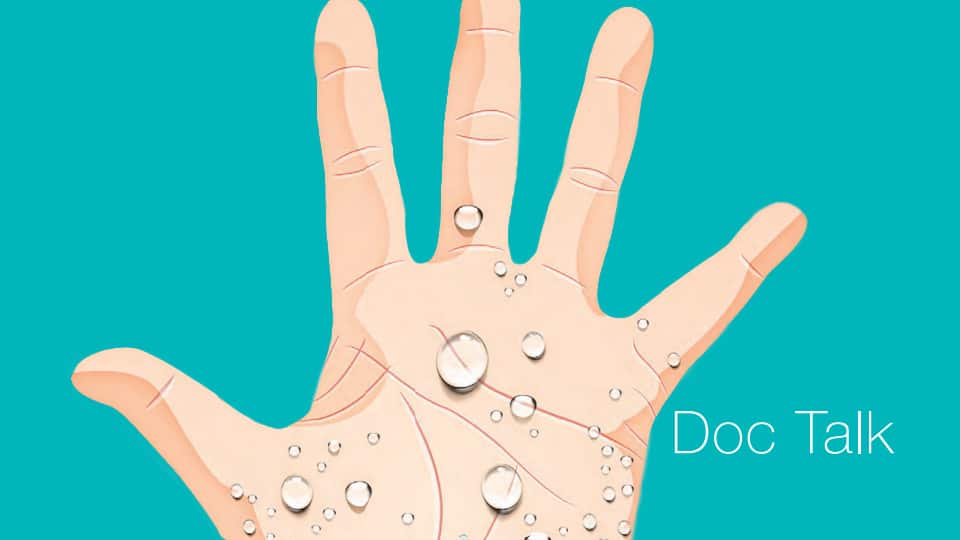No sweat

Greg, an immaculately dressed man who was obviously a white collar professional, walked into the clinic when my nurse called him in. I extended my hand to greet him and introduced myself.
However, he hesitated to shake my hand and quickly sat down.
Taken aback, I tried hard not to read too much into it. Looking at me in despair, he said: “Doctor, I have a problem. My hands can’t stop sweating.” This was his reason for not shaking my hand. Excessive sweating of the palms, known as palmar hyperhidrosis, is not an uncommon problem and can be readily treated.
Epidemiologic studies have found that the condition affects about 1 per cent of the population. It is made worse in Singapore due to the hot and humid climate.
The exact cause of palmar hyperhidrosis is unknown but many believe that sweaty palms arise from over-activity of the sympathetic nervous system. By itself, the condition is not life-threatening nor will it lead to any medically significant problems. Rather, the issue is considered more of a social one.
Many patients afflicted with the condition feel embarrassed whenever they are at social events where they may need to shake hands with others to introduce themselves. When they are anxious or facing a stressful situation, the problem is often exacerbated.
For instance, students who are taking examinations or individuals who need to give presentations to an audience may find their palms sweating so much that sweat literally drips off their hands.
One student described how her examination paper would be soaked with sweat and her writing on her examination paper smudged as a result of the excessive sweating of her hands. Sometimes, the problem is not confined only to the palms.
Another patient, Yulia, walked into my clinic accompanied by the hospital interpreter. Through the interpreter, she explained her somewhat awkward situation – she had armpit odour. Like Greg, Yulia had hyperhidrosis too, but her problem stemmed from her armpits.
Every time she wore a blouse and was out in the humid environment, her underarms would sweat excessively and then produce an unpleasant odour. She was keen to find a solution to her equally embarrassing situation. Sweating is the body’s natural way of regulating temperature.
In fact, the human body has millions of sweat glands and certain areas, such as the palms and underarms, have a higher concentration of the glands. Sweat is, by itself, odourless. But when the body’s skin bacteria metabolise the fatty acids and proteins contained in sweat, the resultant breakdown products can produce an unpleasant scent which is socially sembarrassing.
Medical treatment, such as applying antiperspirants and having botulinum toxin (Botox) injections, can solve these sweaty problems. However, these forms of treatment are, at best, temporary, and the problem tends to recur after some time.
In desperation, many patients seek a surgical solution to a condition which can be socially debilitating. Surgery is offered usually after patients have failed to find solutions through less invasive therapies. Before surgery is contemplated, patients have to be assessed to exclude certain medical conditions which may cause excessive sweating, such as thyrotoxicosis, in which the thyroid hormone is produced in excess.
For patients who have been evaluated thoroughly and been found to have no medical conditions, surgical sympathectomy is an excellent surgical option which provides a long-lasting solution to hyperhidrosis.
With recent medical advancements, needloscopic thoracic sympathectomy can be performed using two small stab incisions under the armpits. With the aid of a small endoscope, the neurosurgeon cuts the thoracic sympathetic chain, which is the chain of nerves that controls sweating. This reduces the amount of sweat produced by the sweat glands in the palms and armpits.
The results are almost instantaneous and patients feel the effects very soon after their surgery – some as early as after recovery from general anaesthesia. The incisions are very small (about 0.5cm each), do not require any stitching and heal within a week.
And because they are under the armpit area, the resultant scars are not prominent. Greg listened intently as I explained the procedure and risks. He requested to have the procedure done as soon as possible. It was done the following day and he enjoyed a speedy recovery.
He now confidently shakes hands with his clients. Although giving business presentations still causes him anxiety, his palms stay dry. Yulia had already done her research and read about surgical sympathectomy from the Internet before coming for her consultation. Like Greg, she proceeded with the procedure and is now rid of her unpleasant armpit odour.
This has enabled her to enjoy outdoor activities without fear of being embarrassed by strong body odour.



